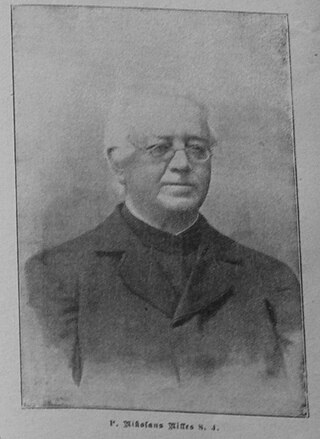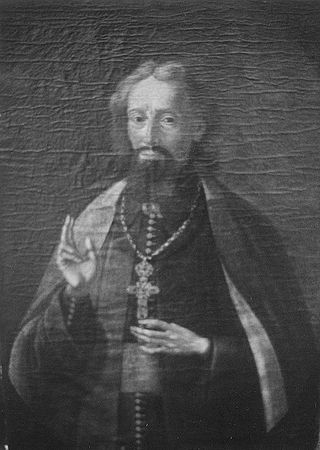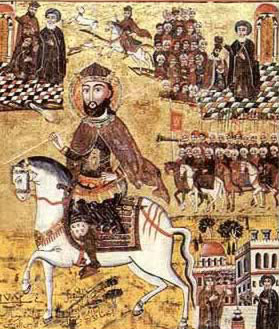Related Research Articles

Shapur II, also known as Shapur the Great, was the tenth Sasanian King of Kings (Shahanshah) of Iran. The longest-reigning monarch in Iranian history, he reigned for the entirety of his 70-year life, from 309 to 379. He was the son of Hormizd II.

Ardashir II, was the Sasanian King of Kings of Iran from 379 to 383. He was the brother of his predecessor, Shapur II, under whom he had served as vassal king of Adiabene, where he fought alongside his brother against the Romans. Ardashir II was appointed as his brother's successor to rule interimly till the latter's son Shapur III reached adulthood. Ardashir II's short reign was largely uneventful, with the Sasanians unsuccessfully trying to maintain rule over Armenia.

Synaxarion or Synexarion is the name given in the Eastern Orthodox, Oriental Orthodox and Eastern Catholic Churches to a compilation of hagiographies corresponding roughly to the martyrology of the Roman Church.

Nikolaus Nilles was a Roman Catholic writer and teacher.

Dayro d-Mor Mattai is a Syriac Orthodox Church monastery on Mount Alfaf in northern Iraq, 20 kilometers northeast of the city of Mosul. It is recognized as one of the oldest Christian monasteries in existence.

Abdecalas, also known as Abdelas, was a Persian priest and martyr, who together with another priest called Ananias, and about a hundred other Christians, was killed under the Persian ruler Shapur II on Good Friday, 345. One of these others was also named Abdecalas.

Mar Shimun Bar Sabbae was the Assyrian Bishop of Seleucia-Ctesiphon, from Persia, the de facto head of the Church of the East, until his death. He was bishop during the persecutions of King Shapur II of the Sasanian Empire of Iran, and was executed along with many of his followers. He is revered as a saint in various Christian communions.
Abdisho, a member of the Church of the East, was a deacon and martyr.
Zanitas and Lazarus were martyrs of the Christian church in the Sasanid Empire.
Acepsimas of Hnaita was a bishop, martyr and saint.
The Martyrology of Rabban Sliba is a book containing the names and feast days of a number of martyrs of the Syriac Orthodox Church. It was edited by P. Paul Peeters, S.J., and published in Analecta Bollandiana #27 in 1908.

Christina, born Yazdoi, was a Sasanian Persian noblewoman and Christian venerated after her death as a virgin martyr.

Manuil Mykhaylo Olshavskyi, O.S.B.M., was the bishop of the Vicariate Apostolic for the Ruthenians in Mukacheve from 1743 to his death in 1767.
Hennadiy Yuriy Bizantsiy, O.S.B.M. was the bishop of the Eparchy of Munkács from 1716 to his death in 1733.

Saints Behnam, Sarah, and the Forty Martyrs were 4th-century Christians who suffered martyrdom during the reign of Shapur II. They are venerated as saints in the Oriental Orthodox Church.

Saint Sargis the General or Sergius Stratelates is revered as a martyr and military saint in the Armenian Apostolic Church. The name Sargis (Sarkis) is the Armenian form of Sergius (Sergios).
The History of Mar Qardagh is a Syriac martyrdom text pertaining to Qardagh, a Sasanian military leader and noble who converted from Zoroastrianism to Christianity. Though the narrative of the text is set during the reign of Shapur II, it was written in the final decades of the Sasanian Empire.
The Martyrology of 411 is the oldest Eastern Christian martyrology. It is written in Syriac and preserved in one of the oldest Syriac manuscripts, British Library, Add MS 12150, dated to November 411.
Barshabba, whose name means "son of the deportation", was the first recorded East Syriac bishop of Merv. He attended the synod of Patriarch Dadishoʿ in 424. Barshabba, or at least his name, lies at the root of an elaborate legend about the introduction of Christianity to eastern Iran and central Asia.

The Martyrs of Persia under Shapur II were Assyrian Christian martyrs who were put to death by Shapur II of Persia for failing to renounce their faith. There may have been several thousand in total. They are remembered as a group in the Roman and Orthodox calendars. The Roman Martyrology gives feast days of 6 April, 22 April and 9 May for different groups.
References
- Holweck, Frederick George (1924). A Biographical Dictionary of the Saints. St. Louis, MO: B. Herder Book Co.
- ↑ Ignatius Aphram I. Barsoum (Ighnāṭyūs Afrām I), Patriarch of Antioch (2003). The Scattered Pearls : a History of Syriac Literature and Sciences. New Jersey: Gorgias Press LLC. p. 164. ISBN 1-931956-04-9 . Retrieved October 9, 2012.
...Saba the youth and his companion Abai in 363...
- ↑ Death year is listed differently in two references – 363 in The Scattered Pearls and 460 in Kalendarium. His death year is listed as 363 in this article because that date corresponds to the reign of Shapur II, King of the Persian Sassanid Empire from 309 to 379.
- ↑ Calendar of Historical Events, Births, Holidays and Observances. MobileReference. 2007. ISBN 9781605011097.
- ↑ Nilles, Nicolaus (1897). Kalendarium manuale utriusque ecclesiae orientalis et occidentalis (in Latin). Vol. 2. p. 379.
S. Abai, m. in Perside, 460.
- ↑ Syriac Biographical Dictionary, Abai, Syriac Not Available (sometime between 335 - 385) Archived 2017-04-16 at the Wayback Machine Retrieved on 6 Feb 2018